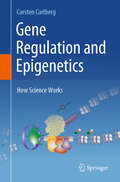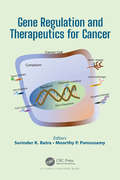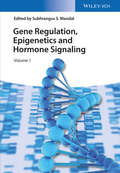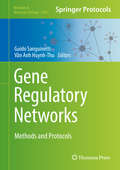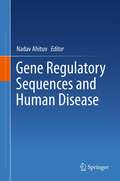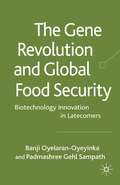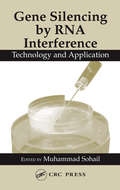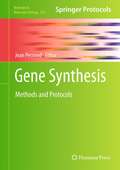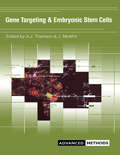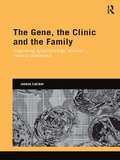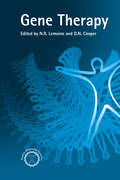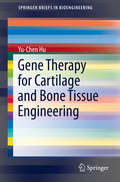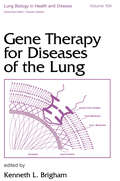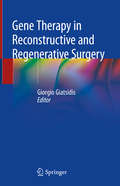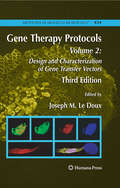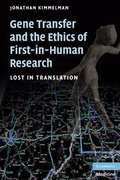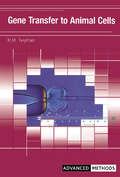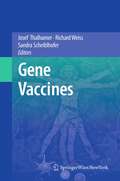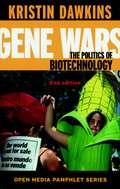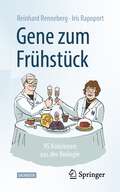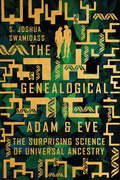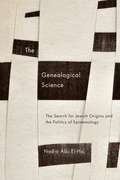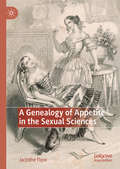- Table View
- List View
Gene Regulation and Epigenetics: How Science Works
by Carsten CarlbergThis book delves into the fascinating realm of eukaryotic gene regulation. The specific expression of genes shapes the phenotype of cells and tissues. The regulation of gene expression, including up- and downregulation, is a fundamental aspect of nearly all physiological processes, both in health and disease. These dynamic processes respond to various daily challenges, such as dietary changes and infections. Therefore, it is crucial for not only biologists and biochemists but also all students in biomedical disciplines to understand gene regulation concepts. This foundational knowledge will benefit them in their specialized fields. A comprehensive understanding of transcription factors and the mechanisms that alter their activity is a fundamental goal of modern life science research. Epigenetics refers to the packaging and accessibility of the genome in each of the trillions of cells in our bodies. The prefix “epi” (meaning “upon,” “above,” or “beyond”) indicates that epigenetic processes do not alter the DNA sequence of our genome, adding a layer of information beyond that encoded in our genome. Genomic DNA is wrapped around complexes of histone proteins, helping it fit into a cell nucleus with a diameter of less than 10 μm. This protein-DNA complex is known as chromatin. The content of this book is linked to the “Molecular Medicine and Genetics” course, which the author has lectured on in various forms since 2002 at the University of Eastern Finland in Kuopio. This book is an updated version of the textbooks “Mechanisms of Gene Regulation” and “Human Epigenomics.” It is divided into 16 chapters. Following two introductory chapters, four chapters explore gene regulation from the perspective of transcription factors, while another four chapters focus on chromatin and non-coding RNA. Three chapters then discuss the impact of epigenetics from a health perspective, and the final three chapters address epigenetics from the perspective of diseases. A glossary in the appendix explains the major specialist terms.
Gene Regulation and Therapeutics for Cancer
by Surinder K. BatraDifferential gene regulation and targeted therapy are the critical aspects of several cancers. This book covers specific gene regulation and targeted therapies in different malignancies. It offers a comprehensive assessment of the transcriptional dysregulation in cancer, and considers some examples of transcriptional regulators as definitive oncogenic drivers in solid tumors, followed by a brief discussion of transcriptional effectors of the programs they drive, and discusses its specific targets. Most targeted therapeutics developed to date have been directed against a limited set of oncogenic drivers, exemplified by those encoding cell surface or cytoplasmic kinases that function in intracellular signaling cascades.
Gene Regulation, Epigenetics and Hormone Signaling
by Subhrangsu S. MandalThe first of its kind, this reference gives a comprehensive but concise introduction to epigenetics before covering the many interactions between hormone regulation and epigenetics at all levels. The contents are very well structured with no overlaps between chapters, and each one features supplementary material for use in presentations. Throughout, major emphasis is placed on pathological conditions, aiming at the many physiologists and developmental biologists who are familiar with the importance and mechanisms of hormone regulation but have a limited background in epigenetics.
Gene Regulatory Networks: Methods And Protocols (Methods in Molecular Biology #1883)
by Guido Sanguinetti Vân Anh Huynh-ThuThis volume explores recent techniques for the computational inference of gene regulatory networks (GRNs). The chapters in this book cover topics such as methods to infer GRNs from time-varying data; the extraction of causal information from biological data; GRN inference from multiple heterogeneous data sets; non-parametric and hybrid statistical methods; the joint inference of differential networks; and mechanistic models of gene regulation dynamics. Written in the highly successful Methods in Molecular Biology series format, chapters include introductions to their respective topics, descriptions of recently developed methods for GRN inference, applications of these methods on real and/ or simulated biological data, and step-by-step tutorials on the usage of associated software tools.Cutting-edge and thorough, Gene Regulatory Networks: Methods and Protocols is an essential tool for evaluating the current research needed to further address the common challenges faced by specialists in this field.
Gene Regulatory Sequences and Human Disease
by Nadav AhituvIn Gene Regulatory Sequences and Human Disease, the Editor will introduce the different technological advances that led to this breakthrough. In addition, several examples will be provided of nucleotide variants in noncoding sequences that have been shown to be associated with various human diseases.
The Gene Revolution and Global Food Security: Biotechnology Innovation in Latecomers
by Banji Oyelaran-Oyeyinka Padmashree Gehl SampathUsing the concept of innovation capacity, this book, using recent field data from countries in Asia and Africa, competently demonstrates how biotechnology can contribute to sustainable economic development. The approach articulates the imperative for developing countries to build up specific capabilities backed up by policies and institutions.
Gene Silencing by RNA Interference: Technology and Application
by Muhammad SohailMaximizing the potential of RNA interference in functional genomics - as well as in the development of therapeutics - continues to be at the forefront of biomedical research. Unlike journal articles, Gene Silencing by RNA Interference: Technology and Application combines essential background to the RNAi field with practical techniques designed by r
Gene Synthesis
by Jean PeccoudThe de novo fabrication of custom DNA molecules is a transformative technology that significantly affects the biotechnology industry. Basic genetic engineering techniques for manipulating DNA in vitro opened an incredible field of opportunity in the life sciences. In, Gene Synthesis: Methods and Protocols expert researchers in the field detail many of the methods which are now commonly used to fabricate DNA . These include methods and techniques for the assembly of oligonucleotide, cloning of synthons into larger fragments, protocols and software applications, and educational and biosecurity impacts of gene synthesis. Written in the highly successful Methods in Molecular BiologyTM series format, the chapters include the kind of detailed description and implementation advice that is crucial for getting optimal results in the laboratory. Thorough and intuitive, Gene Synthese: Methods and Protocols aids scientists in understanding all the different stages of a complex gene synthesis process, while refining their understanding of gene synthesis and determine what part of the process they can or should do in their laboratory and what parts should be contracted to a specialized service provider.
Gene Targeting and Embryonic Stem Cells (Advanced Methods)
by Alison Thomson Jim McwhirGene Targeting and Embryonic Stem Cells is a practical guide designed for the rapidly growing number of researchers who are moving into this field. Provides details on how to culture, transfect and differentiate established cell lines, and how to isolate new cell lines. Gene targeting experiments are described for a number of cell types, including ungulate fetal fibroblasts, murine ES cells, human embryonal carinoma cells and human ES cells, and include protocols for gene-targeting vectors, DNA transfection and RNA interference. The recent isolation of human embryonic stem cells and the potential of these cells for therapeutic applications has generated an entirely new methodology. Similarly, gene targeting methodology has recently been extended to nuclear donor cells in ungulate species. This volume will be invaluable for both new and established researchers in the field of human embryonic stem cells, and to biotech companies engaged in the production of transgenic proteins in livestock, xenotransplantation and the development of animal models.
The Gene, the Clinic, and the Family: Diagnosing Dysmorphology, Reviving Medical Dominance (Genetics and Society)
by Joanna LatimerWhile some theorists argue that medicine is caught in a relentless process of ‘geneticization’ and others offer a thesis of biomedicalization, there is still little research that explores how these effects are accomplished in practice. Joanna Latimer, whose groundbreaking ethnography on acute medicine gave us the social science classic The Conduct of Care, moves her focus from the bedside to the clinic in this in-depth study of genetic medicine. Against current thinking that proselytises the rise of laboratory science, Professor Latimer shows how the genetic clinic is at the heart of the revolution in the new genetics. Tracing how work on the abnormal in an embryonic genetic science, dysmorphology, is changing our thinking about the normal, The Gene, the Clinic, and the Family charts new understandings about family, procreation and choice. Far from medicine experiencing the much-proclaimed ‘death of the clinic’, this book shows how medicine is both reasserting its status as a science and revitalising its dominance over society, not only for now but for societies in the future. This book will appeal to students, scholars and professionals interested in medical sociology, science and technology studies, the anthropology of science, medical science and genetics, as well as genetic counselling.
Gene Therapy (Medical Perspectives Ser.)
by Nicholas R. Lemoine David N. CooperGene Therapy describes the delivery systems now available to target a given tissue with specific gene or oligonucleotide sequences, and explores the utility of animal modules as test systems. In the context of selected disease states, it summarises in vitro and in vivo studies and clinical trials performed to date.
Gene Therapy for Cartilage and Bone Tissue Engineering
by Yu-Chen Hu"Gene Therapy for Cartilage and Bone Tissue Engineering" outlines the tissue engineering and possible applications of gene therapy in the field of biomedical engineering as well as basic principles of gene therapy, vectors and gene delivery, specifically for cartilage and bone engineering. It is intended for tissue engineers, cell therapists, regenerative medicine scientists and engineers, gene therapist and virologists. Dr. Yu-Chen Hu is a Distinguished Professor at the Department of Chemical Engineering, National Tsing Hua University and has received the Outstanding Research Award (National Science Council), Asia Research Award (Society of Chemical Engineers, Japan) and Professor Tsai-Teh Lai Award (Taiwan Institute of Chemical Engineers). He is also a fellow of the American Institute for Medical and Biological Engineering (AIMBE) and a member of the Tissue Engineering International & Regenerative Medicine Society (TERMIS)-Asia Pacific Council.
Gene Therapy for Diseases of the Lung (Lung Biology In Health And Disease Ser.)
by Kenneth L. BrighamThis up-to-the-minute and comprehensive resource lucidly covers gene therapy for lung diseases from existing technologies delivering foreign DNA to the lungs via the airways or circulation to promising new approaches for the further development of safe and efficient gene delivery systems.
Gene Therapy in Reconstructive and Regenerative Surgery
by Giorgio GiatsidisThis book offers an updated overview of the most recent research advances in the field, a comparison of established techniques and methods, a discussion on current experimental and translational challenges, and a commentary on potential opportunities and future directions.Dedicated chapters address and review the preclinical and clinical state-of-the-art of gene therapies for the reconstructive and regenerative surgery of skin and wounds, pathological scars, cartilage, tendons, skeletal muscles, and bio-engineered flaps. A brief guide to developing gene therapy clinical trials in the context of reconstructive and regenerative surgery is also provided.Biomedical and technological innovations are transforming our capacity to use gene therapies to safely and effectively repair, reconstruct, and regenerate tissues that are deficient or have been damaged by trauma and diseases. The targeted and controlled modulation of gene expression in tissues represents a game-changing, next-generation therapeutic tool for the modern reconstructive surgeon, expanding the horizon of regenerative surgery and tissue engineering. Through gene therapies, surgeons can direct (stem) cell differentiation and cell function, modulate the release of growth/transcriptional factors, affect the biological properties of regenerative scaffolds, control tissue inflammation, or induce immune-suppression in composite tissue allotransplants and xenotransplants.Written by renowned reconstructive surgeons and leading experts in each of these fields - from top academic institutions around the globe, the book provides an initial practical guide for veteran and newcomer surgeons alike, as well as for researchers interested in exploring the latest gene-based therapeutic strategies for reconstructive and regenerative surgery.
Gene Therapy , Third Edition, Volume 2: Design and Characterization of Gene Transfer Vectors
by Joseph LedouxIn Gene Therapy Protocols, Volumes 1 & 2, internationally recognized investigators describe cutting-edge laboratory techniques for the study of Production and In Vivo Applications of Gene Transfer Vectors (Volume 1) and Design and Characterization of Gene Transfer Vectors (Volume 2). The field of gene therapy has undergone remarkable advances, promising to impact human healthcare significantly in the twenty-first century. Today’s technologies can deliver genetic material safely and effectively to cells to slow or halt the progression of disease, and to help repair or regenerate damaged or lost tissues. In this second volume of Gene Therapy Protocols: Design and Characterization of Gene Transfer Vectors, readers will find a comprehensive resource of current and emerging methods for the processing and characterization of viral and non-viral gene transfer vectors, as well as promising approaches to design vectors for efficient, targeted and regulated gene delivery and expression. This second volume of the new and completely revised third edition of Gene Therapy Protocols will prove a necessary tool for graduate students and postdoctoral fellows and invaluable to basic and clinical researchers in both industry and academia.
Gene Transfer and the Ethics of First-in-Human Research
by Jonathan KimmelmanHuman gene transfer is widely regarded as one of the most promising technologies for the treatment of a variety of disorders, but it presents practitioners with a variety of difficult ethical questions. Gene Transfer and the Ethics of First-in-Human Research examines the ethical and policy dimensions of testing interventions in human beings for the first time. The book discusses the difficult ethical challenges that arise from attempting to translate laboratory discoveries into clinical applications. These range from which available techniques to use, when to initiate human testing, questions of consent, expectation in public arenas, how to define acceptable risk, and the inclusion of vulnerable or disadvantaged subjects in early phase trials. This book is relevant to ethicists, legal practitioners, policy makers, geneticists and clinicians involved in clinical trials of new medical interventions.
Gene Transfer to Animal Cells (Advanced Methods)
by Richard TwymanGene transfer to animal cells was first achieved more than thirty years ago. Since then, transformation technology has developed rapidly, resulting in a multitude of techniques for cell transformation and the creation of transgenic animals. As with any expanding technology, it becomes difficult to keep track of all the developments and to find a concise and comprehensive source of information that explains all the underlying principles. Gene Transfer to Animals Cells addresses this problem by describing the principles behind gene transfer technologies, how gene expression is controlled in animal cells and how advanced strategies can be used to add, exchange or delete sequences from animal genomes in a conditional manner. A final chapter provides an overview of all the applications of animal cell transformation in farming, medicine and research.
Gene Vaccines
by Richard Weiss Sandra Scheiblhofer Josef ThalhamerThe induction of antigen-specific immune responses after in vivo transfection with expression plasmids has triggered a revolution of vaccine research. After a first hype, evoked by the fascinating options of this method, clinical studies did not reach the ambitious aims and a phase of disillusion ensued. It became obvious that Gene vaccines displayed a weaker immunogenicity in humans than had been observed in the mouse models. Meanwhile these hurdles have been overcome and gene vaccines undergo a renaissance. The present book gives an update of the "world of naked gene vaccines", namely DNA and RNA vaccines. Its content ranges from general mechanisms, inherent immunostimulatory properties and the vast potential to modulate immune responses, to recent successful clinical studies and approved veterinary gene vaccines. Beyond the state-of-the-art of genetic immunization, the reader will be stimulated with a chapter addressing "burning questions".
Gene Wars: The Politics of Biotechnology (Open Media Series)
by Kristin DawkinsDespite technological advances, an alarming number of people in the world go hungry. Even more chilling is the fact that in the future that number will likely increase. In this book, Kristin Dawkins discusses the international policies that are shaping this future, including those that govern the genetic engineering of plants. Dawkins shows how a diversified gene pool is crucial to food production - and how corporate control of the gene pool threatens our collective security.Behind these issues lies the specter of globalization - transnational corporations freely exploiting the resources and consumers of the world while political power shifts to remote international institutions strictly dedicated to commerce. Dawkins challenges those in power to develop global systems of political discourse in the public interest and shows how each one of us can make a difference.
Gene zum Frühstück: 95 Kolumnen aus der Biologie
by Reinhard Renneberg Iris RapoportDie Autoren entführen uns auch in ihrem neuen Werk in die spannende und vielfältige Welt der Biochemie und Biotechnologie. Das Buch befasst sich mit einer Vielzahl interessanter Fragen und Fakten. Gentechnik – darf man das, soll man das oder muss man das? Die Autoren spüren dem Traum vom Jungbrunnen nach und versuchen Paganinis Geheimnis zu lüften. Sie verblüffen uns, wo alte Handarbeitstechniken plötzlich gefragt sind oder giftige Skorpione sich nützlich machen. Geschrieben in Zeiten, in denen Corona uns beutelt, wurden unsichtbare Feinde, und wie wir uns gegen sie wehren, natürlich nicht ausgespart. Nebenbei wird auch geklärt, was brauner Haut und buntem Obst gemeinsam ist, wie Vitamine in den Kuchen kommen und worin Monets Tragik bestand.
The Genealogical Adam and Eve: The Surprising Science of Universal Ancestry
by S. Joshua SwamidassThe Genealogical Adam and Evealongsidehumanancestrygeneticgenealogicalgenealogicalgenealogical
The Genealogical Science: The Search for Jewish Origins and the Politics of Epistemology
by Abu El-Haj NadiaThe Genealogical Science analyzes the scientific work and social implications of the flourishing field of genetic history. A biological discipline that relies on genetic data in order to reconstruct the geographic origins of contemporary populations--their histories of migration and genealogical connections to other present-day groups--this historical science is garnering ever more credibility and social reach, in large part due to a growing industry in ancestry testing. In this book, Nadia Abu El-Haj examines genetic history's working assumptions about culture and nature, identity and biology, and the individual and the collective. Through the example of the study of Jewish origins, she explores novel cultural and political practices that are emerging as genetic history's claims and "facts" circulate in the public domain and illustrates how this historical science is intrinsically entangled with cultural imaginations and political commitments. Chronicling late-nineteenth- to mid-twentieth-century understandings of race, nature, and culture, she identifies continuities and shifts in scientific claims, institutional contexts, and political worlds in order to show how the meanings of biological difference have changed over time. In so doing she gives an account of how and why it is that genetic history is so socially felicitous today and elucidates the range of understandings of the self, individual and collective, this scientific field is making possible. More specifically, through her focus on the history of projects of Jewish self-fashioning that have taken place on the terrain of the biological sciences, The Genealogical Science analyzes genetic history as the latest iteration of a cultural and political practice now over a century old.
The Genealogical Science: The Search for Jewish Origins and the Politics of Epistemology (Chicago Studies in Practices of Meaning)
by Nadia Abu El-HajThe Genealogical Science analyzes the scientific work and social implications of the flourishing field of genetic history. A biological discipline that relies on genetic data in order to reconstruct the geographic origins of contemporary populations—their histories of migration and genealogical connections to other present-day groups—this historical science is garnering ever more credibility and social reach, in large part due to a growing industry in ancestry testing. In this book, Nadia Abu El-Haj examines genetic history’s working assumptions about culture and nature, identity and biology, and the individual and the collective. Through the example of the study of Jewish origins, she explores novel cultural and political practices that are emerging as genetic history’s claims and “facts” circulate in the public domain and illustrates how this historical science is intrinsically entangled with cultural imaginations and political commitments. Chronicling late-nineteenth- to mid-twentieth-century understandings of race, nature, and culture, she identifies continuities and shifts in scientific claims, institutional contexts, and political worlds in order to show how the meanings of biological difference have changed over time. In so doing she gives an account of how and why it is that genetic history is so socially felicitous today and elucidates the range of understandings of the self, individual and collective, this scientific field is making possible. More specifically, through her focus on the history of projects of Jewish self-fashioning that have taken place on the terrain of the biological sciences, The Genealogical Science analyzes genetic history as the latest iteration of a cultural and political practice now over a century old.
A Genealogy of Appetite in the Sexual Sciences
by Jacinthe FloreThis book offers a genealogy of the medicalisation of sexual appetite in Europe and the United States from the nineteenth to twenty-first century. Histories of sexuality have predominantly focused on the emergence of sexual identities and categories of desire. They have marginalised questions of excess and lack, the appearance of a libido that dwindles or intensifies, which became a pathological object in Europe by the nineteenth century. Through a genealogical approach that draws on the writings of Michel Foucault, A Genealogy of Appetite in the Sexual Sciences examines key ‘moments’ in the pathologisation of sexuality and demonstrates how medical techniques assumed critical roles in shaping modern understandings of the problem of appetite. It examines how techniques of the patient case history, elixirs and devices, measurement, diagnostic manuals and pharmaceuticals were central to the medicalisation of sexual appetite. Jacinthe Flore argues that these techniques are significant for understanding how a concern with ‘how much?’ has transformed medical knowledge of sexuality since the nineteenth century. The questions of ‘how much?’, ‘how often?’ and ‘how intense?’ thus require a genealogical investigation that pays attention to the emergence of medical techniques, the transformation of forms of knowledge and their effects on the problematisations of sexual appetite.
Genealogy Standards
by Board for Certification of GenealogistsHow do family historians know they are producing or receiving trustworthy results? This official manual from the Board of Certification for Genealogists, essentially a users' guide for family historians, provides standards for genealogical researchers to assess their own and others' work. <p><p>The revised second edition increases the clarity of DNA and privacy standards. Those standards are especially useful in the twenty-first century, when many genealogists use a complex new tool―DNA testing―and trace living people more often than they did in the past.
